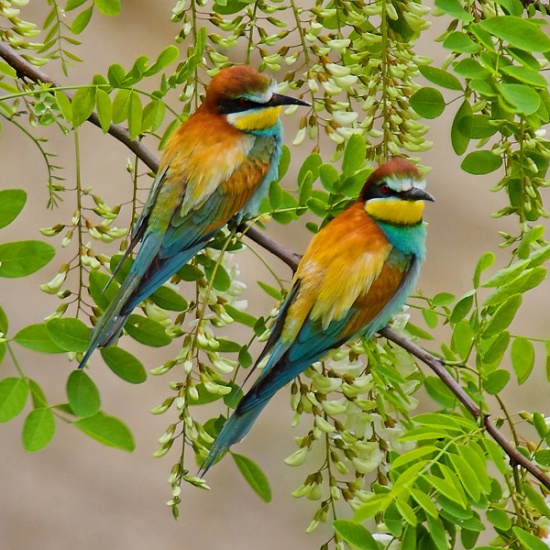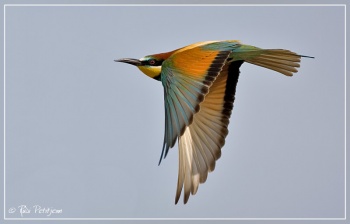(Full stops at ends of sentences.) |
(→External Links: New VSearch and Category added) |
||
| (10 intermediate revisions by 5 users not shown) | |||
| Line 1: | Line 1: | ||
| − | [[Image:European_Bee-eater.jpg|thumb|550px|right|Photo by {{user|Momo|Momo}}<br /> | + | [[Image:European_Bee-eater.jpg|thumb|550px|right|Photo © by {{user|Momo|Momo}}<br />Penthaz, VD, [[Switzerland]], May 2006]] |
;[[:Category:Merops|Merops]] apiaster | ;[[:Category:Merops|Merops]] apiaster | ||
==Identification== | ==Identification== | ||
| − | L. 27-29 cm, including the two long central tail feathers.<br /> | + | L. 27-29 cm (10½-11½ in), including the two long central tail feathers.<br /> |
This species, like other bee-eaters, is a richly-coloured, slim bird. | This species, like other bee-eaters, is a richly-coloured, slim bird. | ||
*Brown and yellow upper parts | *Brown and yellow upper parts | ||
*Green Wings | *Green Wings | ||
*Black beak | *Black beak | ||
| − | Sexes | + | Sexes similar |
==Distribution== | ==Distribution== | ||
| − | Fairly common summer visitor to [[Europe]] and western [[Asia]]. Breeds over much of [[Iberia]], in southern [[France]] and parts of [[Italy]], and from the eastern | + | Fairly common summer visitor to [[Europe]] and western [[Asia]]. Breeds over much of [[Iberia]], in southern [[France]] and parts of [[Italy]], and from the eastern Adriatic to the Black and Caspian Seas. In [[Russia]] breeds north to about 57°N. Found throughout [[Turkey]] and the [[Caucasus]], in northern [[Iraq]] and in scattered parts of the [[Middle East]]. In the Mediterranean breeds on the [[Balearics]], [[Corsica]] and [[Sardinia]], [[Crete]] and [[Cyprus]]. In North [[Africa]] breeds widely across the north-west. Further east breeds over much of [[Iraq]] and [[Iran]] and discontinuously east to western [[China]]. Also breeds in parts of southern [[Africa]]. |
| − | + | [[Image:BijeneterRP092870.jpg|thumb|350px|right|Photo © by {{user|Rudi+Petitjean|Rudi Petitjean}}<br />[[Hungary]], May 2009]] | |
| − | Leaves breeding grounds in August-September to winter in sub-Saharan [[Africa]] from [[Sierra Leone]] to [[Ivory Coast]] and more commonly from [[Tanzania]] to eastern [[South Africa]]. Returns to breeding grounds in April-May. Occurs on passage throughout southern [[Europe]], [[ | + | Leaves breeding grounds in August-September to winter in sub-Saharan [[Africa]] from [[Sierra Leone]] to [[Ivory Coast]] and more commonly from [[Tanzania]] to eastern [[South Africa]]. Returns to breeding grounds in April-May. Occurs on passage throughout southern [[Europe]], North [[Africa]] and the [[Middle East]], regular in small numbers on the [[Canary Islands]]. |
Frequently overshoots on spring migration and rare but annual visitor north to [[Britain]], the North Sea countries and [[Scandinavia]]. Has bred in Britain, Scandinavia, [[Poland]], [[Sicily]] and the [[Canary Islands]] and the first breeding for [[Switzerland]] was recorded in 1991. Vagrants recorded on [[Azores]], [[Madeira]] and [[Cape Verde Islands]]. | Frequently overshoots on spring migration and rare but annual visitor north to [[Britain]], the North Sea countries and [[Scandinavia]]. Has bred in Britain, Scandinavia, [[Poland]], [[Sicily]] and the [[Canary Islands]] and the first breeding for [[Switzerland]] was recorded in 1991. Vagrants recorded on [[Azores]], [[Madeira]] and [[Cape Verde Islands]]. | ||
A rare spring migrant in Britain with under 40 records in most years, the majority in southern [[England]] but also recorded north to [[Shetland]]. In Britain has bred in [[Sussex]] in 1955, two pairs raising seven young and one pair in [[Durham]] in 2002. In the same year breeding also took place in [[Belgium]] and the [[Netherlands]], far north of usual range. | A rare spring migrant in Britain with under 40 records in most years, the majority in southern [[England]] but also recorded north to [[Shetland]]. In Britain has bred in [[Sussex]] in 1955, two pairs raising seven young and one pair in [[Durham]] in 2002. In the same year breeding also took place in [[Belgium]] and the [[Netherlands]], far north of usual range. | ||
| + | ==Taxonomy== | ||
| + | A bird in the bee-eater family ([[:Category:Meropidae|Meropidae]]). | ||
| + | |||
| + | This is a [[Dictionary_M-O#M|monotypic]] species<sup>[[#References|[1]]]</sup>. | ||
| − | |||
| − | |||
==Habitat== | ==Habitat== | ||
Open countryside with a few trees, also woodland edges and clearings and areas of cultivation. | Open countryside with a few trees, also woodland edges and clearings and areas of cultivation. | ||
| Line 28: | Line 30: | ||
Sandy banks along rivers are used for their breeding colonies. Five to eight white eggs are laid at the beginning of June. Both sexes brood the eggs for about three weeks. | Sandy banks along rivers are used for their breeding colonies. Five to eight white eggs are laid at the beginning of June. Both sexes brood the eggs for about three weeks. | ||
===Vocalisation=== | ===Vocalisation=== | ||
| − | + | {{ Audio|Merops apiaster (song).mp3 }} | |
| − | + | ||
==References== | ==References== | ||
| − | #Birds of Iraq | + | #{{Ref-Clements6thAug17}}#Birds of Iraq |
#Birdcheck.co.uk | #Birdcheck.co.uk | ||
| + | {{ref}} | ||
==External Links== | ==External Links== | ||
| − | {{GSearch|Merops | + | {{GSearch|"Merops apiaster" {{!}} "European Bee-eater"}} |
| + | <br /> | ||
| + | {{VSearch|"Merops apiaster" {{!}} "European Bee-eater"}} | ||
| + | {{GS-checked}}1 | ||
| + | <br /> | ||
| + | <br /> | ||
| − | [[Category:Birds]] [[Category:Merops]] [[Category:Bird Songs]] | + | [[Category:Birds]] [[Category:Merops]] [[Category:Bird Songs]] [[Category:Videos]] |
Latest revision as of 23:01, 20 October 2023
- Merops apiaster
Identification
L. 27-29 cm (10½-11½ in), including the two long central tail feathers.
This species, like other bee-eaters, is a richly-coloured, slim bird.
- Brown and yellow upper parts
- Green Wings
- Black beak
Sexes similar
Distribution
Fairly common summer visitor to Europe and western Asia. Breeds over much of Iberia, in southern France and parts of Italy, and from the eastern Adriatic to the Black and Caspian Seas. In Russia breeds north to about 57°N. Found throughout Turkey and the Caucasus, in northern Iraq and in scattered parts of the Middle East. In the Mediterranean breeds on the Balearics, Corsica and Sardinia, Crete and Cyprus. In North Africa breeds widely across the north-west. Further east breeds over much of Iraq and Iran and discontinuously east to western China. Also breeds in parts of southern Africa.
Leaves breeding grounds in August-September to winter in sub-Saharan Africa from Sierra Leone to Ivory Coast and more commonly from Tanzania to eastern South Africa. Returns to breeding grounds in April-May. Occurs on passage throughout southern Europe, North Africa and the Middle East, regular in small numbers on the Canary Islands.
Frequently overshoots on spring migration and rare but annual visitor north to Britain, the North Sea countries and Scandinavia. Has bred in Britain, Scandinavia, Poland, Sicily and the Canary Islands and the first breeding for Switzerland was recorded in 1991. Vagrants recorded on Azores, Madeira and Cape Verde Islands.
A rare spring migrant in Britain with under 40 records in most years, the majority in southern England but also recorded north to Shetland. In Britain has bred in Sussex in 1955, two pairs raising seven young and one pair in Durham in 2002. In the same year breeding also took place in Belgium and the Netherlands, far north of usual range.
Taxonomy
A bird in the bee-eater family (Meropidae).
This is a monotypic species[1].
Habitat
Open countryside with a few trees, also woodland edges and clearings and areas of cultivation.
Behaviour
They can be found feeding and roosting communally.
Diet
As their name suggests, their diet is virtually restricted to bees and wasps.
Breeding
Sandy banks along rivers are used for their breeding colonies. Five to eight white eggs are laid at the beginning of June. Both sexes brood the eggs for about three weeks.
Vocalisation
References
- Clements, J. F., T. S. Schulenberg, M. J. Iliff, D. Roberson, T. A. Fredericks, B. L. Sullivan, and C. L. Wood. 2017. The eBird/Clements checklist of birds of the world: v2017, with updates to August 2017. Downloaded from http://www.birds.cornell.edu/clementschecklist/download/
- Birds of Iraq
- Birdcheck.co.uk
Recommended Citation
- BirdForum Opus contributors. (2024) European Bee-eater. In: BirdForum, the forum for wild birds and birding. Retrieved 28 April 2024 from https://www.birdforum.net/opus/European_Bee-eater
External Links
GSearch checked for 2020 platform.1





